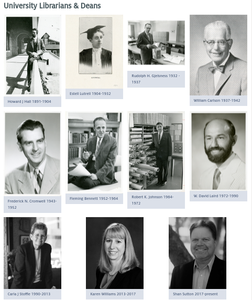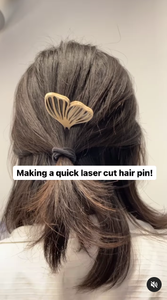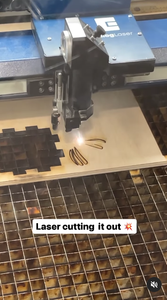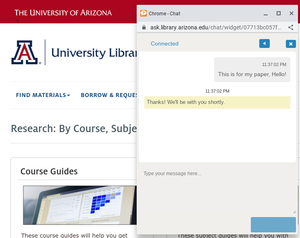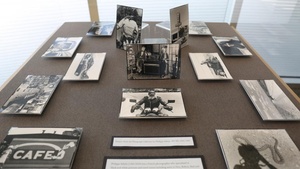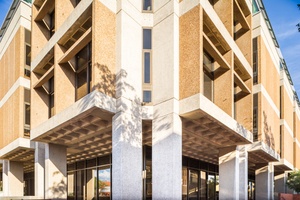Formation:
The library of the University of Arizona was first constructed within the basement of Old Main. By 1902 the collection reached six thousand volumes and seventy periodicals. In 1904, the University of Arizona hired their first librarian, Estelle Lutrel, who oversaw the move of the entire collection into its own building, known as the Douglass building, would serve as the university’s only library and museum building.
Pictured above, Old Main, Douglas Building, and Main
In 1927, the library was moved into the Arizona State Museum. Modeled after the Boston Public Library, the reading porch provided would remain a no smoking zone, under Lutrel’s management.
In 1959, a Fine Arts library was established as a branch of the university’s library system. It would later be joined by a Science-Engineering building in 1963.
In 1977, the University of Arizona Main Library was completed, and would go on to hold 9 million volumes. As well as state of the art computers. In 2013 the university of arizona established a health sciences library to accommodate the growing number of students studying under the university’s nursing program.
In 2020, the most recent set of renovations took place, and the main library was remodeled with an open floor plan on the first floor leading into the basement floor.
Deans:
The University of Arizona’s Deans of the library have consisted of predominantly white men, starting with Howard Judson Hall. Howard Judson Hall was a professor of English and began his deanship at the age of 22. He would serve as dean until 1904. Since then 10 other deans have preceded him, 3 have been women. There have been no people of color as acting dean of the University of Arizona Library.
The Library Deans of the University of Arizona
The Main Library has two separate listings of hours, as students to access of ‘cat cards’ can enter the building at later hours.
Public hours to the Main library: Student Access to the Main Library
Monday -Thursday : 7am-9pm Monday-Thursday: 7am-11:59pm
Friday: 7am-6pm Friday: 7am-6pm
Saturday: 11am-6pm Saturday: 11am-6pm
Sunday: 1pm-9pm Sunday: 1pm-11:59pm
CATalyst
The university’s Main library houses ‘CATalyst’ on the second floor entrance of the building. It is a workshop space with access to technology for both students and patrons of the library. The studio was completed as of January of 2020, but was shut down for a brief period during COVID-19 restrictions. Catalyst opened back up to the public along with the University of Arizona main library in March of 2021. CATalyst also offers certification classes, including 3D printing, laser cutting, and embroidery
“At CATalyst you can: Explore and use our equipment, including laser cutters and 3D printers
Attend our events and workshops to learn new maker skills, like 3D modeling and sewing
Create your own media and projects in our spaces, including podcasts and videos
Get certified in 3D printing, laser cutting, and embroidery.”
- a statement from the University of Arizona Main library CATalyst webpage
A short form video, known as a 'TikTok', shows a student making her own hairpin using a laser cutter at the CATalyst studio
A vast array of equipment is also available to use. Students are also allowed to borrow said equipment for class projects or personal projects. The borrowing of technology beyond books and maps has allowed for an equal learning experience for students from different economic backgrounds.
Technology to borrow:
IPAD, DSLR Camera, Graphing Calc, Macbook, Mobile Wifi Hotspot, PC laptop, Recording equipment, Maker tools, Projectors, Scanners, and VR kits.
Equipment available for use within the Main library:
- 3D printers
- CnC machines
- Data visualization wall
- Electronic prototyping cabinet
- Desktops equipped with Adobe photoshop and Microsoft word
- Laptops and USBc Docks
- Laser cutters
- Microphones and Podcasting Equipment
- Sewing machines
- Vinyl cutters
- VR equipment
Researching online
Researching within the library can be achieved through analog usages such as books, maps, and microfiche. The library also offers the ability to use one’s own laptop and connect to the two wifi sources it provides. These include “UofA” wifi for students, and “U of A Guest”, for patrons who are not actively enrolled. On the library’s main web page, visitors can also access it’s digital library which includes full texts, but also theses, dissertations, and guides. The various guides include tutorials for navigating the online catelogs, a guide to avoiding plagiarism, and how to evaluate online information as a reputable source, among many other guides.
Pictured above are the University of Arizona's Library website's homepage, guides to research and study, and an online chat feature to talk directly to a library associate.
Physical Catelog
The physical catalog within the library system is organized by its field of study. Data pertaining to mathematics and science is kept in the Science and Engineering library, whereas books surrounding art and photography can be found within the Fine Arts library. However, any student or patron can request a hold on any item and choose to pick it up at the Main library. Media within the physical catalog system include: encyclopedias and dictionaries, religious texts, academic research papers, maps, aerial photographs, and GIS geospatial data. The University of Arizona libraries has a total of 6,800,038 print volumes and 1,759,433 electronic books. This is not including the media within the Health Sciences location.
Pictured above, a patron wearing an 'air pod' studying the library's journals, second photo includes a patron reviewing the library's maps found on the first floor
Special Collections
The University of Arizona Main library also houses a special collections department. This includes artifacts, transcripts, and even government documents. Below is a statement from the library,
"We offer access to rare and unique materials for scholars, researchers, and the public.”
The special collections department holds key artifacts from various communities around Tucson, such as the “Arizona Queer Archives”.
“The Arizona Queer Archives centers community participation in the building and collecting of LGBTQI histories throughout the state of Arizona and the US-Mexico borderlands. It collects manuscripts and organizational records, ephemera, oral histories and other records that tell the stories of what it means to be LGBTQI in the region.”
The archive has such findings as gay liberation papers, and Tucson commission on Gay, Lesbian, Bisexual, and Transgender issued collections.
Pictured above, the Gay women's of Tucson meet up pamplet, an exhbit on French colloquium photo display in the Special collections
Staffing
At the current time of writing, the staff directory within the University of Arizona Libraries displays a total of 180 people staffed, however this is a mere estimation as student workers or part time faculty are not accredited.
Architecture of the Main Library:
The University of Arizona Main library was built by the architecture firm Friedman & Jobusch in 1972 and constructed by M.M. Sundt Construction Co. The building was inspired by Midcentury Modern design. Demion Clincoof, author of the historical website SOSBrutalism, describes the building in further detail below.
“The use of precast exposed aggregate concrete and poured-in-place concrete created allowed for an exposed structural system. The building includes a concrete coffered ceiling. The University of Arizona Library marked the end of Tucson’s monumental civic brutalist buildings.”
- The main library has a total of five floors. The first floor houses it’s chinese and japanese collections, maps, desktop computers, group study rooms, printing kiosks and 3D printers.
- The second floor has Ask Us desks, Hold shelf and interlibrary loan, Books that Matter (Browsing collection), Lost and found, CATalyst Studios, Self checkout machines, printing kiosks, and a Scholars' Corner.
- The third floor has Administrative offices, Printing kiosks, Children's literature, Current journals (A-HF 1399), Microfilm, Newspapers, Quiet study rooms, Reference collections, and Student lockers.
- The fourth and fifth floors are considered quiet study floors. Patrons are expected to keep talking to below volumes lower than average and cellphones silenced. They also hold current journals (HF 1400-PQ), (PR-ZA), Office of Digital Innovation & Stewardship, UA Press, User Experience, and Assessment & Analytics.
The fifth floor also holds a dining area for its staff which is separated via keycoded doors. The eating area has a fridge, sink, coffee machine, and balcony.
Pictured above, The University of Arizona Main Library photographed from various angles
Sources:
University of Arizona Libraries, © 2023 Arizona Board of Regents for the University of Arizona, accessed 04/08/2023, https://lib.arizona.edu/
SOS Brutalism, Demion Clinco, Tucson Historic Preservation Foundation, accessed 04/09/2023, https://www.sosbrutalism.org/cms/18455720




